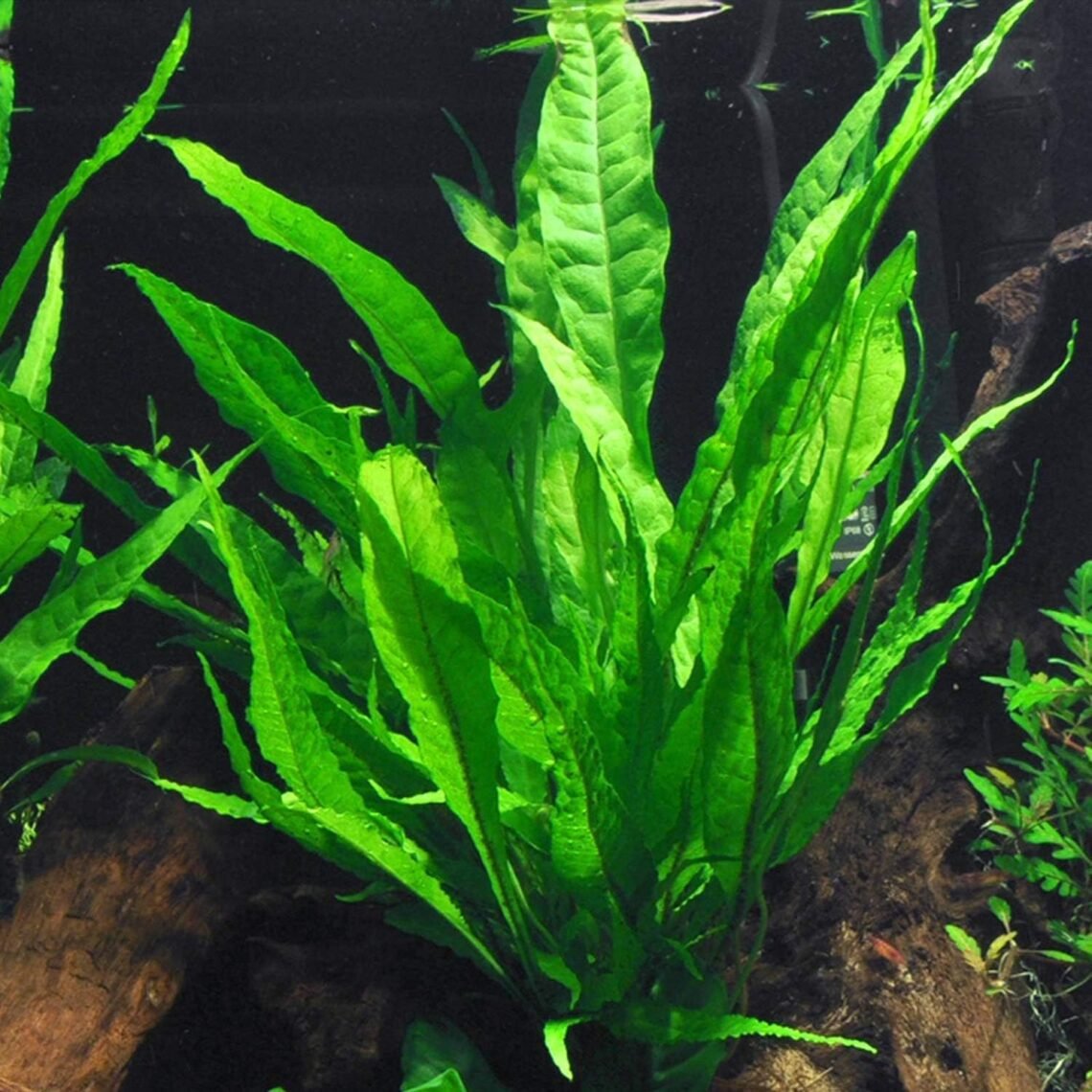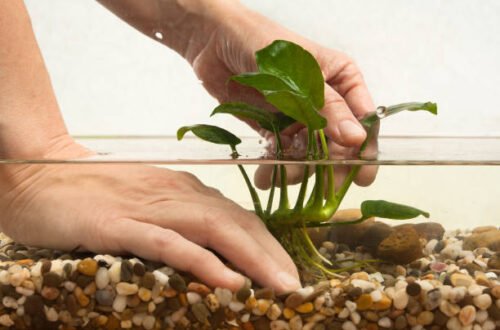Amazon Sword plants are one of the most popular and versatile aquatic plants in the fishkeeping hobby. Known for their broad, lush green leaves and ability to thrive in a variety of tank conditions, they’re a fantastic addition to almost any freshwater aquarium. When I first started adding live plants to my tanks, the Amazon Sword was my go-to, and for good reason. They’re hardy, look stunning, and provide a natural habitat for fish. In this guide, I’ll share everything you need to know about Amazon Sword plants, from how to plant them to keeping them healthy and thriving.
What Are Amazon Sword Plants?
Amazon Sword (Echinodorus) is a genus of aquatic plants native to the Amazon Basin in South America. They belong to the Alismataceae family and are widely used in aquariums due to their large, sword-shaped leaves and their ability to grow fully submerged. These plants can grow quite large, making them an excellent background plant for larger aquariums. There are several species and varieties of Amazon Swords, but the care for each is quite similar.
Step 1: Choosing the Right Amazon Sword Plant
Before you get started, it’s important to choose the right variety for your aquarium. While most Amazon Swords are similar in appearance, some grow much larger than others, which can impact how they fit in your tank.
1.1 Common Amazon Sword Varieties
- Echinodorus amazonicus: The classic Amazon Sword, with long, broad leaves that can reach up to 20 inches tall.
- Echinodorus bleheri: Very similar to E. amazonicus but tends to have even broader leaves.
- Echinodorus parviflorus: A smaller version of the Amazon Sword, growing up to about 12 inches, ideal for mid-sized tanks.
- Echinodorus ‘Ozelot’: A hybrid variety that features interesting red or brown spots on its leaves, adding visual variety.
Choose the variety that suits your tank size and aesthetic. I personally love the classic E. amazonicus for its bold presence, but in smaller tanks, E. parviflorus is a better fit.
Step 2: Setting Up the Tank for Amazon Sword
Amazon Sword plants are fairly easy to care for, but they do have specific preferences when it comes to lighting, substrate, and water conditions.
2.1 Ideal Tank Size
While some species of Amazon Swords stay small, many grow large and can easily outgrow a small tank. Ideally, you’ll want a tank of at least 20 gallons. For larger varieties like Echinodorus amazonicus, a tank of 40 gallons or more is recommended to give them plenty of space to spread out.
2.2 Lighting Requirements
Amazon Swords do well in moderate to high lighting. For best results, aim for about 2 to 3 watts per gallon. If you’re using LED lights, make sure they’re rated for plant growth, as Swords need sufficient light to photosynthesize and maintain their lush green color. I’ve noticed that in lower light setups, Amazon Swords can still survive but tend to grow more slowly and may develop yellowing leaves.
2.3 Substrate Needs
Amazon Swords are heavy root feeders, which means they need a nutrient-rich substrate. While they can survive in standard aquarium gravel, they’ll thrive much better in a planted tank substrate that’s designed to hold nutrients, like Fluval Stratum or Eco-Complete. Another option is to add root tabs near the plant’s base to provide extra nutrients if you’re using regular gravel. In my tanks, I always use root tabs, and the growth difference is noticeable within weeks.
2.4 Water Parameters
Amazon Swords are quite tolerant of a range of water conditions, which makes them suitable for a variety of aquariums. Here’s what they prefer:
- Temperature: 72°F to 82°F (22°C to 28°C)
- pH: 6.5 to 7.5
- Hardness: Soft to moderately hard water (3 to 12 dGH)
I’ve kept Amazon Swords in a variety of tanks with slightly different pH and hardness, and they’ve been quite adaptable. Just try to keep things consistent, as rapid changes in water parameters can stress the plant.
Step 3: Planting Amazon Sword in Your Aquarium
Planting your Amazon Sword properly is key to its long-term health. Here’s how to do it:
3.1 Trim the Roots Before Planting
Before placing your Amazon Sword in the tank, inspect the roots. If the roots are too long, trim them to about 2-3 inches. Trimming encourages new growth and makes it easier to plant. I usually do this when I first get the plant from the store, as the roots can be quite long.
3.2 Plant in the Substrate
Dig a small hole in the substrate and place the plant’s roots in it, ensuring the crown (the point where the roots meet the leaves) stays above the substrate. Burying the crown can cause the plant to rot. I’ve made this mistake before, and it can quickly damage an otherwise healthy plant. Be gentle when planting to avoid damaging the roots.
3.3 Space It Out
Give the plant enough room to spread its leaves. Amazon Swords can grow quite wide, so avoid crowding them with other plants. A good rule of thumb is to leave at least 6-8 inches of space around it.
Step 4: Caring for Your Amazon Sword
Once your Amazon Sword is planted, it’s relatively low maintenance. However, there are a few things to keep in mind to ensure it thrives.
4.1 Fertilization
Since Amazon Swords are heavy root feeders, they benefit greatly from regular fertilization. In addition to a nutrient-rich substrate, I recommend using root tabs every 1-2 months, as well as a liquid fertilizer that contains essential nutrients like iron, potassium, and trace minerals. I’ve found that without iron, the leaves can start to turn yellow, so it’s worth investing in a good quality plant fertilizer.
4.2 Pruning
As your Amazon Sword grows, it will naturally shed older leaves, which will turn yellow or brown. Trim these leaves regularly to encourage new growth and prevent decaying matter from affecting the water quality. I prune my Swords every couple of weeks to keep them looking their best and to make room for new leaves.
4.3 Dealing with Algae
Algae can be a common problem on Amazon Sword leaves, especially in tanks with high light. If you notice algae building up on the leaves, reduce the lighting period to 6-8 hours a day or introduce algae-eating fish like Otocinclus or Amano shrimp. I also gently wipe the leaves with my fingers during water changes to keep them clean.
Step 5: Propagation and Growth
One of the great things about Amazon Swords is how easy they are to propagate. With the right care, they’ll naturally produce new plants over time.
5.1 Runners and Plantlets
Amazon Swords reproduce by sending out runners, which are long stems that grow small plantlets at intervals. Once these plantlets develop a few leaves and roots of their own, you can carefully snip them off and plant them elsewhere in the tank. I’ve propagated several new plants this way, and it’s an easy way to fill out your aquarium or even start a new tank.
5.2 Dividing the Plant
If your plant grows too large, you can divide it by cutting through the root ball with a sharp knife. Make sure each section has its own set of leaves and roots. I’ve only done this with particularly large Swords, as they tend to grow best when left undisturbed.
Step 6: Common Problems and How to Solve Them
Even though Amazon Swords are hardy, they can sometimes run into issues. Here are a few common problems and how to fix them.
6.1 Yellowing Leaves
Yellow leaves are usually a sign of nutrient deficiency, especially a lack of iron. I recommend increasing your fertilization, particularly with iron-rich supplements. If your substrate is old, consider replacing or replenishing it with fresh root tabs.
6.2 Holes in Leaves
If you see small holes appearing in the leaves, this is often a sign of potassium deficiency. Start dosing with a liquid fertilizer that includes potassium to correct this issue.
6.3 Melting
Melting is when the plant’s leaves start to decay after being introduced to a new tank. This is common when moving a plant from one environment to another, such as from a store to your tank. Don’t panic—this is normal. Trim away the melting leaves, and new growth will usually appear within a few weeks.
Amazon Sword plants are a beautiful and functional addition to any freshwater aquarium. With their broad leaves and lush green appearance, they provide excellent cover for fish, help oxygenate the water, and improve the overall aesthetics of your tank. While they are relatively low-maintenance, providing the right substrate, lighting, and fertilization will ensure they thrive. Whether you’re a beginner or an experienced aquarist, Amazon Swords are a fantastic choice for creating a natural, vibrant aquascape.
FAQs
1. How fast do Amazon Swords grow?
Amazon Swords grow at a moderate pace. With good lighting and fertilization, you can expect new leaves to appear every couple of weeks. Full maturity can take several months.
**2. Can I grow Amazon Swords in a low
-tech tank?**
Yes, Amazon Swords can survive in low-tech setups with low light, but their growth may be slower, and their leaves might not be as vibrant. Regular fertilization is key in low-tech tanks.
3. Do Amazon Sword plants need CO2?
While Amazon Swords don’t require CO2 to grow, adding CO2 can significantly boost their growth and help them reach their full potential.
4. How large do Amazon Sword plants get?
Amazon Swords can grow quite large, with some varieties reaching up to 20 inches in height and spreading wide. Make sure your tank has enough room for them to expand.
5. Are Amazon Swords safe for all fish?
Yes, Amazon Swords are generally safe for most freshwater fish. They provide shelter and places to hide, making them especially beneficial in community tanks. However, large herbivorous fish like goldfish may nibble on the leaves.





